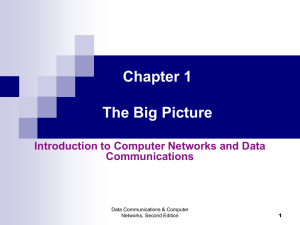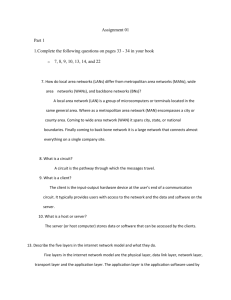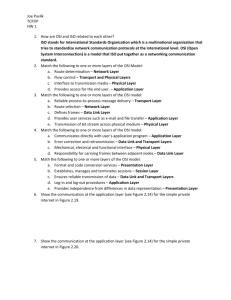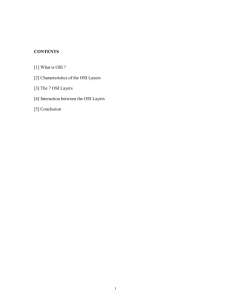OPEN SYSTEM INTERCONNECTION : OSI
advertisement
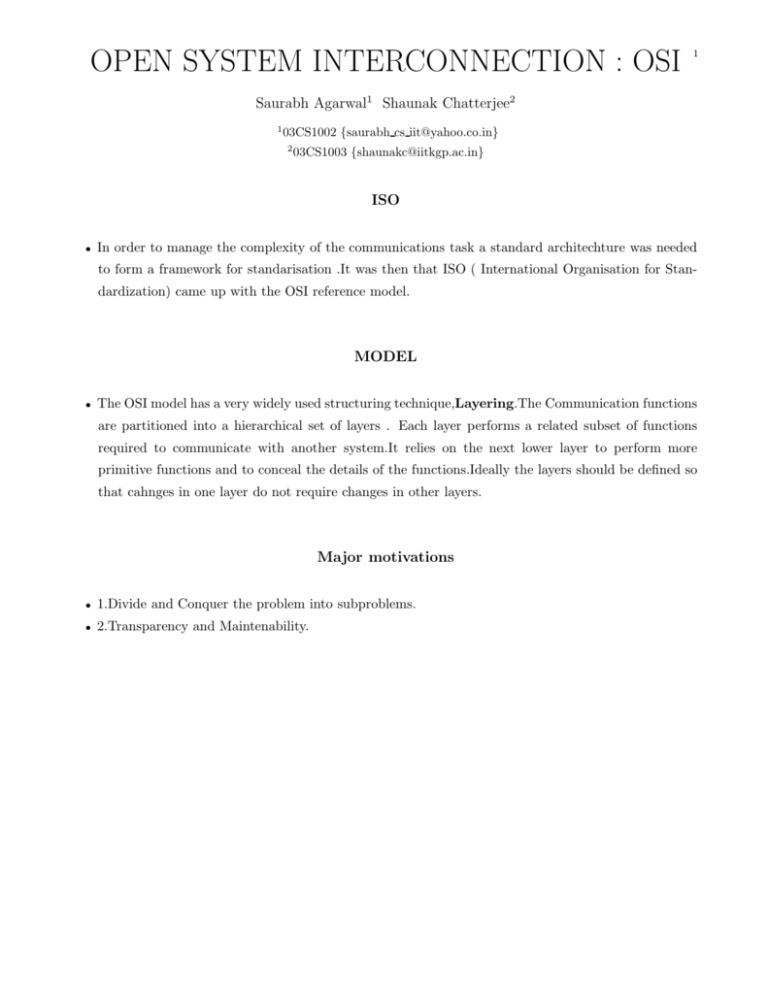
OPEN SYSTEM INTERCONNECTION : OSI
1
Saurabh Agarwal1 Shaunak Chatterjee2
1
03CS1002 {saurabh cs iit@yahoo.co.in}
2
03CS1003 {shaunakc@iitkgp.ac.in}
ISO
•
In order to manage the complexity of the communications task a standard architechture was needed
to form a framework for standarisation .It was then that ISO ( International Organisation for Standardization) came up with the OSI reference model.
MODEL
•
The OSI model has a very widely used structuring technique,Layering.The Communication functions
are partitioned into a hierarchical set of layers . Each layer performs a related subset of functions
required to communicate with another system.It relies on the next lower layer to perform more
primitive functions and to conceal the details of the functions.Ideally the layers should be defined so
that cahnges in one layer do not require changes in other layers.
Major motivations
•
1.Divide and Conquer the problem into subproblems.
•
2.Transparency and Maintenability.
Principles used in defining OSI layers
•
The basic idea behind the design of the OSI model was to create enough layers to make each layer
maganeably small ,but it should not have so many layers that the processing overhead imposed by
the collection of layers is burdensome.
•
The important principles are:
– Do NOT create so many layers that the task of describing and intergrating the layers is more difficult
than necessary.
– Create a boundary at a point where the number of interactions across the boundary are minimized
and use past experience to ensure high probability of success.
– Create separate layers to handle functions that are different in the process performed or the technology involved.
– Collect similar functions into the same layer.
– Allow bypasing of sublayers.
– Allow changes of functions and protocols to be made within a layer with affecting other layers.
– Create a layer of easily localised functions so that the layer can be totally redesigned to make use
of advances in technology.
– Create further subgrouping and organisation of functions to form sublayers within a layer.
SEVEN LAYERS IN THE OSI MODEL
•
1. Physical Layer.
– The physical layer covers the physical interface between the devices and th rules by which bits are
pased from one to another .The physical layer has four important characteristics :
– Mechanical:Relates to the pysical properties of the interface to a transmission medium.
– Electrical:Relates the representation of bits(e.g.,in terms of voltage levels)and the data transmission
rate of bits.
– Functional:Specifies functions performerd by individual cricuits of the physical interface between
a system and the transmission medium.
– Procedural:Specifies the sequence of events by which bit streams are exchanged across physical
medium.
2
•
2. Data Link Layer.
– The datalink layer attempts to majke the physical layer more reliable and provides the means to
activate , maintain and deactivate the link.The principle service provided by the data link layer to
higher layers is error detection and control. Thius witha fully functional datalink layer protocol
the higher layer may assume error-free transmission over the link.
•
3. Network Layer.
– The Network layer provides for the transfer of information between end systems across some sort of
communications network .It relieves higher layers of the need to know anything about the underlying
data transmission and switching technologies used to connect systems.
– There can either be a direct point-to-point link between stations in which case there may be no need
for a network layer because the datalink layer can peform the necessary function of managing the
link.
– The systems could be connected across a single network such as a circuit switching and packetswitching network. Fig.1.0 shows how OSI architechture accomodates the presence of a network.
The packets that are created by the end-system pass sthrough one or more network nodes that
act as relays between the two end systems.The first three layers are concerned with attaching and
communicating with the network.
– The two end systems might not even be connected to the same network and might wish to communicate.This case requires the use of internetworking technique which is beyond the scope of this
text.
•
4. Transport Layer.
– The transport layer provides a mechanism for the exchange of data between end-systems. The
connection-oriented transport service ensures that data are delivered error-free, in sequence with
no loss or duplications.The transport layer may also be concerned with the use of network services
and providing a requested quality of service to session entities.For example,the season entity may
specify acceptable error rates,maximum delay, priority and security.
– In the TCP/IP protocol suite, there are two common transport layer protocols :
∗ 1.TCP: connection oriented Transmission control protocol
∗ 2.UDP: connectionless User Datagram Protocol
3
•
5. Session Layer.
– The Session layer provides the mechanism for controlling the dialogue between applications between
applications in end-systems.The functions performed by the session layer are:
∗ 1.Dialogue discipline:This can be two-way simultaneous(full duplex) or two-way alternate(half
duplex).
∗ 2.Grouping:The flow of data can be marked to define groups of data.This would signal the host
computer to start processing that group of data.
∗ 3.Recovery:The session layer can provide a checkpointing mechanism, so that if a failure of some
sort occurs between checkpoints ,the session entity can retransmit all data since last checkpoint.
•
6. Presentation Layer.
– The presentation layer defines the format of data to be exchanged betwen applications and offers
application programs a set of data transmission services .The presentation layer defines the syntax
used between application entites and provides for the selection and subsequent modification of the
representation used.
•
7. Application Layer.
– The application layer provieds a means for application programs to access the OSI environment.This
layer contains management functions and generally useful mechanisms to support distributed applications.
I. THE 7-LAYERED OSI ARCHITECTURE : A brief review
The OSI standard comprises of 7 layers : The physical layer, the data link layer, the network layer, the
transport layer, the session layer, the presentation layer and the application layer. The functionalities of
each layer has been briefly described below :
1. The Physical Layer : It is concerned with the transmission of raw bit streams over a physical medium.
Depending upon the physical medium, bit stream might have to be moderated before transmission.
2. The Data Link Layer : This layer provides for reliable transfer of data over a physical link. Some
additional information is incorporated into the Data link headers to check correctness of data.
3. The Network Layer : The Network Layer provides connection and switching mechanisms to route
packets from one sysem to another. This is the highest layer that a packet reaches at intermediate
nodes, during transmission.
4. The Transport Layer : This layer provides reliable, transparent transfer of data between end-points.
It also provides end-to-end error recovery and flow control.
4
5. The Session Layer : This layer establishes, manages and terminates connections between co-operating
applications.
6. The Presentation Layer : It provides independence to the application processes from differences in
data representation. Encryption and decryption will also fall under this layer.
7. User’s Application Layer : The user interacts with this layer.
II. Parallel Development to OSI
The OSI standard is a more hypothetical model. Parallely, ARPANET was developed and the rudimentary versions of TCP/IP were developed and they gained more popularity. These protocols follow
the basic OSI model with different modifications.
III. The path of a data packet from one terminal to another
A Protocol Data Unit (PDU) is created at one terminal. It then comes down from the Application layer,
Presentation layer, ... right down to the Physical layer. At each layer, an appropriate header is added.
When it fina The packet (complete with the user data and the headers) then leaves the source terminal.
Fig. 1. Figure on OSI data packet tracking
At intermediate terminals, the packet moves from Physical layer to Data Link layer to the Network layer.
Along the way, the corresponding headers are stripped. The Network layer of the intermediate node
(Router) adds a modified Network header. Then the packet moves down to the Data Link layer and then
5
the Physical layer. lly reaches the destination node, the packet goes up from the Physical layer upwards,
right up to the Application layer. The headers are stripped along the way. At the Application layer, the
final header is stripped off and the user data is available to the specific application program.
IV. Data Encapsulation
The data packet keeps growing in size as it comes down the hierarchy of layers, and reduces in size as
it moves upwards from the Physical layer to the Application layer. This is because each layer adds its
own header to the existing data packet. The header contains information which enables the particular
layer to carry out its functionalities. Some layers also add trailers.
Fig. 2. Figure on Data Encapsulation
6



